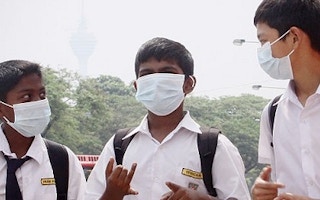Sixty-nine million people were exposed to toxic haze as a result of last year’s devastating wildfires in Indonesia, a new study has found.
Little is known about the health impacts of Indonesia’s annual fires, which spread uncontrollably because the country’s vast peat swamp zones have been widely drained and dried by the palm oil and pulp and paper industries. This renders the land highly flammable.
Smoke from last year’s fires drifted as far as East Africa and the western Pacific Ocean. In September, researchers from Harvard and Columbia Universities released findings that 100,300 people in Indonesia, Malaysia and Singapore are likely to have died prematurely as a result of exposure to the air pollution produced by the fires.
The new study, published in Scientific Reports, estimates that between 6,150 and 17,270 people died prematurely during September and October 2015, when the fires were at their peak.
The previous study’s higher estimate is due to its also accounting for the deaths that occurred in the months after the fires, Paola Crippa, the latest study’s lead author, told Mongabay.
“
If such epidemiological studies were available, we could more accurately describe the relationship between pollution levels and number of premature deaths, and therefore reduce the uncertainty in our final deaths estimates.
Paola Crippa, study lead author and research associate, School of Civil Engineering and Geosciences, Newcastle University
“In other words,” she said, “in our study we are quantifying the number of premature deaths that may have occurred only due to the intense pollution episode of the wildfires in fall 2015.”
Crippa is a research associate in the School of Civil Engineering and Geosciences at Newcastle University.
The Indonesian government has said that the fires sickened 500,000 people, but maintains that only 24 people died as a direct result of the fires. The Singaporean and Malaysian governments also cast doubt on the Harvard study.
The latest research was based on simulations from an air quality model and epidemiological studies, a type of study not without limitations in Indonesia.
No epidemiological study linking air pollution levels to the associated health impacts has ever been conducted in Indonesia, Crippa said, forcing her team to rely on studies from Europe and the US.
“If such epidemiological studies were available, we could more accurately describe the relationship between pollution levels and number of premature deaths, and therefore reduce the uncertainty in our final deaths estimates,” she said.
The researchers also would have liked to validate their estimate with local hospitalisation data. But such information is scarce.
“If local governments would agree to collect, organise and release such data, this would allow scientists to better serve the community with reliable information on possible health impacts and mitigation strategies,” Crippa said.
This story was published with permission from Mongabay.com










